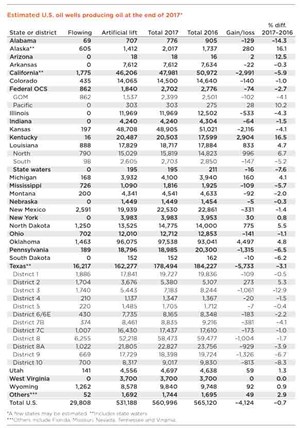The number of active, producing oil wells in the U.S. remained relatively stable, dropping slightly last year, despite a significant increase in drilling from 2016 into 2017. World Oil data indicate that the total number of productive oil wells declined 0.7%, from 565,120 in 2016 to 560,996 last year.
Texas had a significant uptick in active wells during the past year, but producing oil wells did not follow suit as the number fell 3.1% during 2017, to 178,494. Losses were reported in all but one (11 of 12) of the state’s Railroad Commission districts. District 2 was the outlier, jumping from 5,107 producing wells to 5,380, a 5.3% gain. District 8, with its large number of Permian basin wells, eased off 1.7%, to 58,473 wells. Just over 90% of all Texas wells are on artificial lift. DUCs remain a problem in Texas, with 2,777 waiting on completion at the end of 2017.
Louisiana experienced a 4.7% gain in active oil wells last year, at 18,717, up from 17,884 in 2016. Northern Louisiana saw its active oil wells rise 6.7% last year, to 15,819. In southern Louisiana, active wells dropped 5.2%, to 2,703. Wells on artificial lift comprised more than 95% of all oil producers in Louisiana.
MID-CONTINENT. The second-highest number of producing oil wells in 2017 was reported in Oklahoma, which experienced a 4.8% gain last year, with 97,538 active wells. North Dakota was up 5.5% in 2017, totaling 14,775 active oil wells. Kansas reported 2,116 fewer wells, for a 4.1% decline to 48,905, with 99.6% of these on artificial lift.
WEST/ROCKIES. The number of active wells decreased 5.9% in California last year, to 47,981, with 96.3% on artificial lift. Colorado reported a minor 1.0% drop to 14,500 productive wells last year. Wyoming and Utah reported 92 and 59 more wells, respectively.
EAST. In the eastern U.S., Pennsylvania exhibited the largest percentage drop in active wells, at 6.5%, to 18,985. In Ohio active wells declined 1.1%, to 12,712. Illinois decreased 4.3%, down 533 wells to 11,969, all on artificial lift. West Virginia’s tally was unchanged at 3,700 wells. Kentucky experienced a healthy 16.5% increase with 99.9% employing artificial lift.
FEDERAL WATERS. According to U.S. governmental data, the number of active oil wells in federal waters of the Gulf of Mexico fell 4.1%, to 2,399. Conversely, on the Pacific OCS, the well count gained 28, for a 10.2% increase to 303 wells. ![]()

- Coiled tubing drilling’s role in the energy transition (March 2024)
- Shale technology: Bayesian variable pressure decline-curve analysis for shale gas wells (March 2024)
- Digital tool kit enhances real-time decision-making to improve drilling efficiency and performance (February 2024)
- E&P outside the U.S. maintains a disciplined pace (February 2024)
- U.S. operators reduce activity as crude prices plunge (February 2024)
- Drilling advances (January 2024)
- Applying ultra-deep LWD resistivity technology successfully in a SAGD operation (May 2019)
- Adoption of wireless intelligent completions advances (May 2019)
- Majors double down as takeaway crunch eases (April 2019)
- What’s new in well logging and formation evaluation (April 2019)
- Qualification of a 20,000-psi subsea BOP: A collaborative approach (February 2019)
- ConocoPhillips’ Greg Leveille sees rapid trajectory of technical advancement continuing (February 2019)



